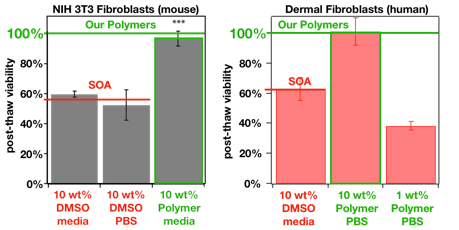Technology summary
Cryopreservation science has seen only limited progress in recent decades. The discovery and development of a non-toxic, universal approach to complex cell and tissue cryopreservation could transform medicine through preservation of cell therapy products, organ banking, and lead to advancements that would decrease mortality and improve quality of life. The freezing of water causes both mechanical and osmotic toxicity1. State-of-the-art cryoprotectants (e.g., DMSO, glycerol, formamide, butandiol) alleviate freezing damage to an extent, but are toxic themselves to cells post-freezing. For instance, there are few effective protocols for the cryopreservation of various types of stem cells, precluding effective banking of stem cells for clinical applications. Furthermore, almost 70% of US donor hearts go un-transplanted, largely due to preservation time limits on assessment and matching (1.)
Dr. Lynd’s lab at The University of Texas at Austin has developed a novel, polymer-based approach to cryopreservation. The polymer-based approach presented is not only non-toxic but also more efficacious compared to current approaches. Quantitative cryopreservation is possible, allowing near 100% post-thaw survival after prolonged storage at –196°C. State-of-the-art provides 60% post-thaw survival, whereas Dr. Lynd's system regularly provides quantitative (ca. 95%+) post-thaw survival.

Key benefits
- Non-toxic
- Enables near quantitative tissue and cell viability
- Flexible use with multiple applications
- Can be implemented with standard cell culture protocols

